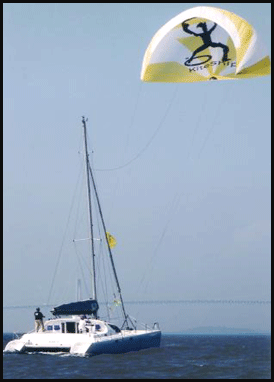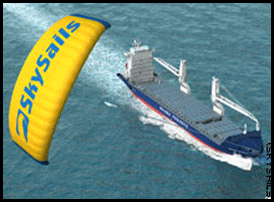Kite traction is not a new concept. Instances of using kites to pull water craft and land vehicles are well recorded in the time line of kite history.
Oral histories tell of people of the Pacific islands using kite-like traction sails long before written records of their use were available. In England, George Pocock used a series of steerable kites to pull his "Char Volant" along roads to record speeds over long distances in 1826.
Recent innovations by New Zealand kite designer Peter Lynn have helped to power sleds across ice in Greenland and pull people on small catamarans, known as "Kite-Cats" on a regular basis.
In July and August of 2006 Anne Quemere of France completed the first solo crossing of the Atlantic Ocean in a kite powered boat. It is a remarkable story and an amazing demonstration of the power and versatility of kite powered sailing craft.
 Now, KiteShip a privately held California corporation based in Martinez, CA, with facilities in Palo Alto, CA and Adelanto, CA., is proposing to use massive kites in a commercial manner to support the movement of large ships and reduce the consumption of fossil fuels. The company's mission statement states:
Now, KiteShip a privately held California corporation based in Martinez, CA, with facilities in Palo Alto, CA and Adelanto, CA., is proposing to use massive kites in a commercial manner to support the movement of large ships and reduce the consumption of fossil fuels. The company's mission statement states:
"KiteShip develops and markets Very Large Free Flying Sails (VLFFS) and control systems, technology and techniques for launching, controlling and recovering same aboard boats, ships, industrial and aerospace applications. Such craft may include pleasure and racing yachts, small and large commercial vessel builds and refits, life and vessel saving devices, research and commercial vessels and aerospace / industrial applications both inshore and at sea."
In October of 2006, KiteShip was selected winner of the Transportation Category of the California Clean Tech Open with their very large traction kites, which reduce ship owners' crippling fuel costs by up to 25 percent, and vastly reduce emissions of greenhouse gases and pollutants. KiteShip was featured in an article in the May 2006 issue of Popular Science magazine.
Currently, all KiteShip applications have been targeted at the ocean going sail boat market. Planning is now underway to assist commercial maritime transit with their Very Large Free Flying Sails. The focus of KiteShip will be on reducing the use of fossil fuels, reducing ship operating costs, and increasing ocean crossing time.
 SkySails, a German company, is working toward the same goal of kite assisted transportation on the high seas. The SkySails web site claims that:
SkySails, a German company, is working toward the same goal of kite assisted transportation on the high seas. The SkySails web site claims that:
"By using the SkySails-System, a ship‘s fuel costs can be reduced by 10- 35% on annual average, depending on wind conditions. Under optimal wind conditions, fuel consumption can temporarily be reduced by up to 50%. Even on a small, 87 metre cargo ship, savings of up to 280,000 euros can be made annually.
In 2007 the first SkySails-Systems with towing-kite areas of up to 320m² for cargo vessels will be available. In 2007 series production of the SkySails systems for super yachts, in 2008 series production for cargo vessels will start."
Clearly, kite traction has come a long way from its humble beginnings pulling the small ocean canoes of Pacific Islanders.